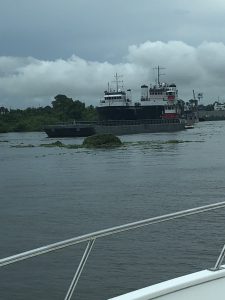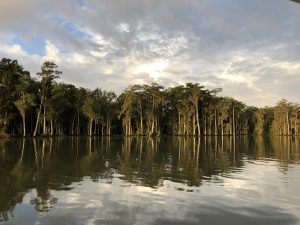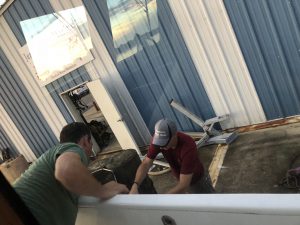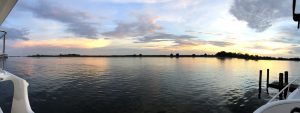5-6 September 2018: The Atchafalaya Swamp
On Wednesday the 5th, we slept in and stayed the day in Morgan City. Ironically even though we were stalled in Morgan City because of Gordon, the sky was a clean, clear, rain-washed blue and a friendly sun shone from dawn to dusk. We washed the boat, made what minor repairs we needed to make, and rested. Buying supplies at the local hardware store, we were the beneficiaries of the Shrimp and Petroleum Festival. Apparently, Lays wanted to test drive a new flavor of chips, and totally overwhelmed the local retailers with free samples. The manager was desperate to get rid of chips, and we are now well stocked. Cajun Spice Lays is very yummy, if you’re interested.
And speaking of yummy, we made a trek to Rita Mae’s Kitchen. It was an unassuming, say ugly even, old building off the main drag. Inside, the specials were written on a large whiteboard, and the tables were old and sticky from the climate and much use. The patrons were watching the evening news with salacious glee as details of Bob Woodward’s new book, Fear, were being announced. Very surprisingly, we had stumbled into a blue restaurant. Even so, we were careful not to offend. Rita Mae specialized in Southern cooking, and good it was. Robert got the breaded and fried pork chop with red beans and rice. Breck got a serving of jambalaya with fried catfish, and I got a shrimp and oyster po’ boy. We fell on that food and glasses of sweet tea like famine victims. Sweet potato pie and pecan pie for dessert and we could barely move after dinner.
The next day we were eastbound again on the Intracoastal Waterway headed to Jean Lafitte, some eighty or more miles down the waterway. The halfway mark would be a town called Houma, which was the local Native American word for red.
This day, the air was so humid everything was sweaty. The windows of the pilot house sweated from inside and out. The floors were tacky with humidity and everything was damp. It didn’t get better as the day wore on. Pop-up squalls followed us most of the day, and the chewy air seemed to make all the various stinks worse. We were all genuinely thankful that by the time dusk came, the skies cleared and we were able to tie up in relative dryness.
We pushed from Morgan City at oh-crap o’clock in the morning, even before the sun rose. The lock just two miles from where we moored would close at 0700 hours for repairs, so we needed to be on the other side before then. Oh goodie! Let’s lock in the dark! Luckily for us, we were able to pull down Google maps while still at Morgan City, so we all reviewed the lay of the waterway beforehand. And when we got there, the water levels had equalized, so the lock stood open and we just had to carefully put-put through. It was a bit spooky.
The stretch of the Intracoastal Waterway between Morgan City and the town of Houma is what one thinks of when one thinks of when one says they’re in the swamp in Louisiana. There is water as far as the eye can see. What “land” there might be is nominal at best. Tall gray- trunked cypress trees weep Spanish moss in Southern gothic profusion. At this time of year, water hyacinths grow with all the vegetative fury they could muster, straining and stretching to capture the sun above the waterline. That meant that rafts of the stuff were everywhere, and sometimes it looked as if the boat were headed down a scraggly field. Sometimes the hyacinths piled up into more solid looking masses that had to be dodged at inopportune times.

WATER HYACINTHS GOING CRAZY.
We pit-stopped in Houma to pump our poop tanks. The soil there was the color of old wine, explaining the name. Three young men were hanging out at the pump-out station, and in true Southern fashion offered their help. They came out in a rain squall to help us tie up, and the young man who offered to take my line—a muscular young black man with a gold chain and a beautiful face—took the line and held it like it was a snake that might bite him. Just to be sure, we walked the line together to the pylon. It turned out that the pump-out station was a popular place for tugs to do shift change. We watched the old crew come off of a tug and the three men waiting there to hop on board.
From Houma, we made our way through the Atchafalaya swamp. We didn’t have much company. There was the occasional tug with its barges stacked two, three, or sometimes more in front of it. And on a number of times, we saw honest-to-god swamp boats with the great fan in the back and outsized rooster-tails of water in the aft. Boy do those things make noise!


We got to Lafitte with twenty minutes to spare. Unfortunately, we had another challenge before we could stand around popping beers and congratulating ourselves on our boating prowess. The transient moorage dock was a jumble of mismatched pylons strapped together with rusting cables and sticking out every which way like a mouthful of rotten teeth. In order to feel as if we were actually safely moored, the boys constructed a fender board from a piece of salvaged (and sodden) 2×6, some rope and two fenders.
A fender board featured in a very helpful book that Breck brought with him—The Handbook of Sailing, by Bob Bond. When Gordon was threatening to be a problem, I read the chapter on weather, and somewhere in there, Mr. Bond discussed using a fender board to protect a sailboat being placed in drydock. The fenders are lashed perpendicular to the board and the whole contraption is hung so that the pylon can ride on the board while the two fenders ride on your fiberglass. No owies and no crying, in theory.

As night fell on the very sleepy town of Lafitte, the bugs came out. We were, after all, in a swamp. A little bit later came the pesticide truck to coat the marina with insecticidal fog. Needless to say, we stayed buttoned up in the salon, plotting out the next day’s journey. Tomorrow, we will go through New Orleans, down the Mississippi, and out into salt water again. We hope to get as far as Gulfport, Mississippi. The sea state forecast looks good, and hopefully will hold for the second part of our journey, down the west coast of Florida.
